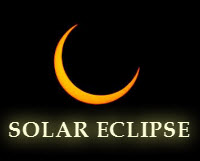 We are rapidly approaching what is undoubtedly one of the celestial highlights of the year, the spring equinox, which falls on March 20th. What, the spring equinox? Yes but, this year’s spring equinox will not be the anonymous affair it normally is, but will be marked with something rather more fitting, and for a lucky few, very much more memorable.
We are rapidly approaching what is undoubtedly one of the celestial highlights of the year, the spring equinox, which falls on March 20th. What, the spring equinox? Yes but, this year’s spring equinox will not be the anonymous affair it normally is, but will be marked with something rather more fitting, and for a lucky few, very much more memorable.
For a start, the moon turns new only 14 hours after reaching lunar perigee: the moon’s closest point to Earth in its orbit, so this moon is a super moon, actually a new super moon, normally not visible in our sky. However, this one will be as it swings in front of the Sun, causing a total solar eclipse to herald the return of spring....at least it will should you lie directly under the path of totality. (Much joy and anticipation in the Faroe Islands and Svalbard.)
Few phenomena rival this wondrous spectacle, a magnificent and coincidental outcome of planetary orbital mechanics, manifest all too briefly in action as our nearest star is occulted by the moon causing its shadow to cut a swath across a part of our globe.
As far as this particular swath goes, it's a case of 'near and yet so far' for the UK, with the moon’s shadow sweeping up across the north east Atlantic region between Iceland and Britain missing Scotland by a few hundred miles. But let's not be down cast, for a very substantial partial eclipse will be witnessed from our neighbourhood, which from Whitby will amount to around 91%, only 5% less than the 1999 eclipse, as seen from Whitby.
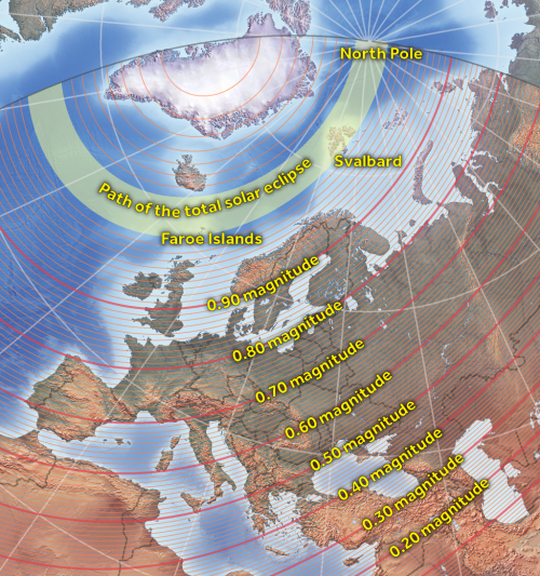
20th March Solar Eclipse: The path to totality - Whitby sees a 91% Eclipse
The eclipse is a morning event, with mid-eclipse occurring around 09:37h. The eclipse starts just over an hour before this, and ends around an hour after it, at 10:42h.

Viewing
As astronomers we should all know about the dangers of solar observing, but please do observe all due care and diligence when attempting to view the sun by whatever method chosen. Never look directly at the sun through optical aids or the naked eye without appropriate certified filters. If you do not have a suitable filter, use the projection method. If any society members require Baader solar sheet filter for use with their scope etc, we have a sizeable piece to be utilised. Safe methods and how to use solar film will be covered and demonstrated at our monthly meeting in March.
As regards the whereabouts of WDAS members on the morning of the 20th, the bandstand on pier road would seem to be the most practical choice. If the weather is fine we will be there from 08:15h until 10:30h.
Solar Observation - Safety Points
Observing a solar eclipse or any phenomena involving the Sun, such as a transit, safety is always of paramount importance. Never directly look at the Sun through any optical instrument unless a suitable solar filter is used, failure to do so and you could permanently damage your eyesight; remember the Sun is 1,000,000 times brighter than the Moon.
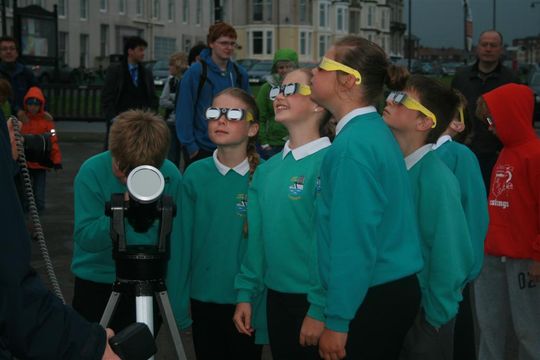
Filtered Scope and Solar Viewing Eye-specs method of viewing a Solar Eclipse
The small ‘screw on eyepiece’ type sun filters sometimes supplied with cheaper small telescopes can shatter due to excess heat - do not use them on any account – please introduce them to the head of a hammer-forcefully. Home-made filters such as smoked glass, exposed film negative and extra dark sun glasses do not stop harmful rays from penetrating your eyes. Do not be tempted to use them.
Use only authorised solar filters such as Mylar and Baader solar film which are 99.99% safe to use at the objective end of a telescope, do not use them across an eyepiece, You can also utilise solar spectacles or a No14 or above welders glass (hand held) for short periods of observation, but never wear solar glasses and look through an eyepiece at the Sun (yes I have seen people about to attempt this).
Unless you have the correct type of solar filter, the safest way to view the solar disc is by projection.
Projection Method
Items of equipment required:
- Telescope - a refractor or reflector - aperture size does not matter; in fact a smaller aperture size is more preferable as it cuts down heat transmission on lenses or mirrors.
- Binoculars can also be used, preferably tripod mounted, but be sure that the lens and eyepiece on one half are capped. (Obvious to astronomers, but apparently not so for everyone)
- You will also require a sheet of white card and ideally, a cardboard box.
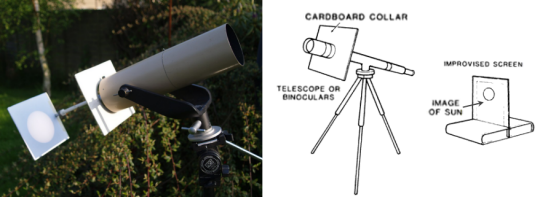
Projection Method of observing a Solar Eclipse
Projection is a simple technique for viewing the Sun, but care must still be exercised. Obtain a cardboard box and insert a piece of white card in the bottom of it (roughly A4 or A3 size or cut to the appropriate dimension of your box) Taking another piece of card approx 30-50cm square cut a hole in the middle of it just large enough for it slide snugly over the telescope or binocular tube. If using a star diagonal with your scope this second piece of card is not required.
Position the box around 1 metre behind the telescope or binoculars allowing the Suns image to fall onto it. To accomplish this:
- Semi-lock the telescope tube so that it can still be moved and aim in the direction of the Sun by sighting along it.
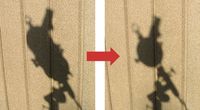 Make sure that end caps, including any finder scope caps are firmly in place. As an indication of how close you are, look for the smallest shadow cast by the tube onto the card in the box.
Make sure that end caps, including any finder scope caps are firmly in place. As an indication of how close you are, look for the smallest shadow cast by the tube onto the card in the box.- The telescope should then be aligned. Insert a low powered eyepiece and remove the telescope end cap, but not the finder scope ones. A bright circular disk should be visible on the card, this is the suns image. Adjust the focus accordingly until the image becomes clear and sharp revealing any features visible on or against its disc.
In the case of a solar eclipse the dark silhouette of the lunar limb will be apparent.
This procedure can take a little time if you are unfamiliar with the movement of a scope, so don’t get frustrated and be tempted to look through the eyepiece, this is how accidents happen.
- Log in to post comments

